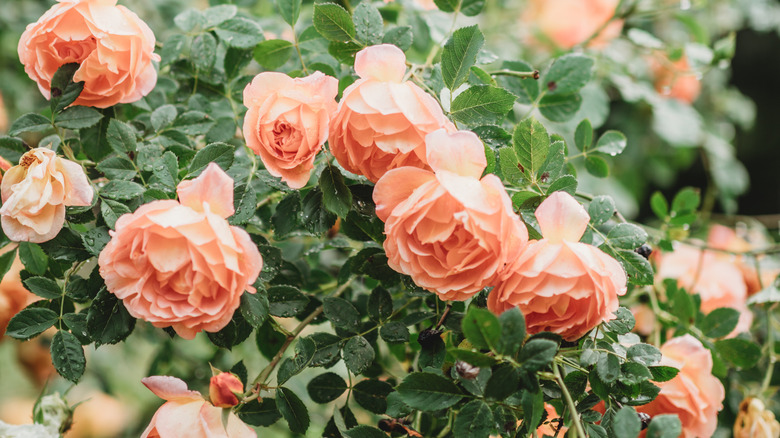A favorite of floral and garden lovers, roses have been a staple in gardens and yards for centuries. There are over 30,000 varieties of a rose, according to Country Garden Roses, varying in color and shape, with some being hybrid species that have been cultivated over time. Beyond their beautiful colors and attractive scents, roses are great host plants for insects and pollinators. Additionally, they can capture nitrogen oxide and ozone particles, which makes them excellent plants for the environment. Is there anything roses can’t do?
Many gardeners take pride in the roses they grow. But a beautifully blooming rose garden often requires a lot of time and strategizing to get right. It all starts with planting at the right time. In an exclusive interview with House Digest, Liz Will, a Master Gardener, certified garden coach, and founder of Learn To Grow Gardens, shares the best time to plant roses for blooming success.
Roses are coming out of dormancy in spring

Most plants don’t grow all year long. When temperatures dip low, many go into dormancy and stop growing until it warms up. This includes roses. “When the daytime temperatures rise and the amount of daylight increases, roses start to come out of their dormant state,” explains Liz Will. “This is a great time to get them in the ground. When a rose bush comes out of winter dormancy, new growth is triggered. This is the perfect time for a freshly planted rose bush to start putting out new roots and settle into its forever home.”
You’ll notice when temperatures begin to rise and stabilize. But it’s also a good idea to know the frost dates in your area to allow them to influence your planting time. During the spring, a light freeze is when temperatures fall between 29 degrees and 32 degrees Fahrenheit, according to Almanac. However, it’s essential to look at the frost dates for your area because of the differences in climate. Checking the weather forecast can give you an idea of when the last frost will occur.
The ground is soft and warm

Air isn’t the only thing to warm up as temperatures rise – the ground does, too. “In the spring, when the air and ground start to warm up, the ground softens from winter’s freeze,” says Liz Will. “This will allow you to work with the soil, breaking up any clumps and creating soft, fluffy soil for your roses. The warmth of the soil will help encourage your roses to put forth new roots, and the soft soil will help those roots stretch out and grow.”
Soil temperature is important for roots, and if you’re serious about ensuring the soil is ready for planting, you can get a soil thermometer. You can stick these in the ground to get a reading for how warm or cold the soil is. Generally speaking, 65 to 75 degrees Fahrenheit is a suitable soil temperature for planting, according to Empress of Dirt. To be thorough, however, check both day and night temperatures.
Spring rains

Gary Matuschka/Shutterstock
All plants need water to grow and roses are particularly thirsty. “An important step after planting new roses is to keep them well watered until they’re established,” Liz Will says. “Keeping them watered helps new roses to settle in, spread new roots, and can help prevent transplant shock. In the spring, the increased amount of rain does some of the work for you. Be sure your newly planted rose bush receives about a gallon of water every two to three days.”
Providing lots of water for your rose bushes promotes bright colors and robust petals. It’s best to water the ground around your roses early in the day. Avoid getting petals and foliage sopping wet, as this can cause disease and helps them spread. However, once a week on hot or sunny days, you can give roses a quick spray to keep them moist and get rid of dust or pests.
A full season of growth

Veranika Dzik/Shutterstock
Planting times tell you the best point in the year to plant flowers or vegetation. “Although roses can be planted anytime the ground is not frozen, spring gives them an entire season to settle in before the ground freezes,” explains Liz Will. “Your roses will have plenty of time to recover from transplant shock, spread their roots, and establish themselves before winter arrives.” An established plant has a better chance of growing back the following year even stronger.
Planting too late in the season can stunt their growth and shorten their bloom time. Many rose varieties bloom continuously, according to Venus et Fleur, which means they can have multiple bloom cycles between May and October, giving you constant blooms from spring through fall. However, other varieties bloom only once or twice per season. So before planting, it’s wise to find the best time to plant that variety to ensure the best growth.
Availability and variety

Gary Matuschka/Shutterstock
If you’re not growing roses from seeds and would rather plant some that are fully grown, you have to know the best time to shop. “One of the reasons spring is a great time to plant roses is simply the wide availability and variety at garden centers and online nurseries,” says Liz Will. “The big push for buying and planting is in the spring, and the earlier you shop, the greater variety you’ll have to choose from. Plus, commercial growers encourage roses to bloom in time for spring market sales. This allows you to see the blooms up close and choose a color or type that suits you best.”
Before shopping, it’s always a good idea to familiarize yourself with the different types of roses. According to Jackson and Perkins, there are three main categories: old garden roses, wild roses, and modern garden roses. Each has its own planting and watering needs and blooming cycles. Doing a little research and heeding expert advice can help you find the perfect roses for your garden.



